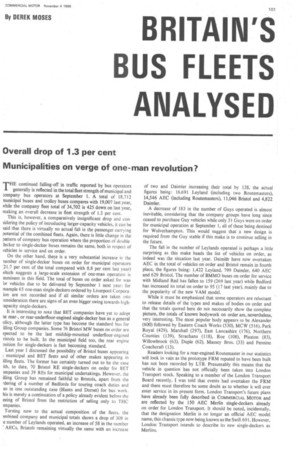By DEREK MOSES BRITAIN'S
Page 103

If you've noticed an error in this article please click here to report it so we can fix it.
BUS FLEETS ANALYSED
Overall drop of 1.3 per cent Municipalities on verge of one-man revolution?
THE continued falling-off in traffic reported by bus operators generally is reflected in the total fleet strength of municipal and ompany bus operators at September 1. A total of 18,712 municipal buses and trolley buses compares with 19,007 last year, while the company fleet total of 34,702 is 425 down on last year, making an overall decrease in fleet strength of 1.3 per cent.
This is, however, a comparatively insignificant drop and considering the policy of introducing larger-capacity vehicles, it can be said that there is virtually no actual fall in the passenger-carrying potential of the combined fleets. Again, there is little change in the pattern of company bus operation where the proportion of double. decker to single-decker buses remains the same, both in respect of vehicles in service and on order.
On the other hand, there is a very substantial increase in the lumber of single-decker buses on order for municipal operators :21.7 per cent of the total compared with 8.8 per cent last year) which suggests a ilarge-scale extension of one-man operation is mminent in this field. The total of buses on order asked for was or vehicles due to be delivered by September 1 next year; for ;xample 65 one-man single-deckers ordered by Liverpool Corporaion are not recorded and if all similar orders are taken into :onsideration there are signs of an even bigger swing towards high:apacity single-deckers.
It is interesting to note that BET companies have yet to adopt he rear-, or rear-underfloor-engined single-decker bus as a general olicy, although the latter type has become the standard bus for Illing Group companies. Some 76 Bristol MW buses on order are xpected to be the last rnidship-mounted underfloor-eng,ined ristols to be built. In the municipal field too, the rear engine osition for single-deckers is fast becoming standard.
Last year I discussed the possibility of Bristol buses appearing t municipal and BET fleets and of other makes appearing in illing fleets. The former has certainly turned out to be the case lth, to date, 70 Bristol RE single-deckers on order for BET )mpanies and 39 REs for municipal undertakings. However, the illing Group has remained faithful to Bristols, apart from the rdering of a number of Bedfords for touring coach duties and so in one outstanding case (Hants and Dorset) for bus work. his is merely a continuation of a policy already evident before the eeing of Bristol from the restriction of selling only to THC mmanies.
Turning now to the actual composition of the fleets, the imbined company and municipal totals shows a drop of 308 in .e number of Leylands operated, an increase of 58 in the number AECs, Bristols remaining virtually the same with an increase of two and Daimler increasing their total by 128, the actual figures being: 16,691 Leyland (including two Routenaasters), 14,546 AEC (including Routemasters), 11,046 Bristol and 4,822 Daimler.
A decrease of 183 in the number of Guys operated is almost inevitable, considering that the company groups have long since ceased to purchase Guy vehicles while only 31 Guys were on order for municipal operation at September 1, all of these being destined for Wolverhampton. This would suggest that a new design is required from the Guy stable if this make is to continue selling in the future.
The fall in the number of Leylands operated is perhaps a little surprising as this make heads the list of vehicles on order, as indeed was the situation last year. Daimldr have now overtaken AEC in the total of vehicles on order and Bristol remain in fourth place, the figures being: 1,422 Leyland, 799 Daimler, 640 AEC and 629 Bristol. The number of BMMO buses on order for service with Midland Red has fallen to 159 (269 last year) while Bedford has increased its total on order to 95 (17 last year), mainly due to the popularity of the new VAM model.
While it must be emphasized that some operators are reluctant to release details of the types and makes of bodies on order and that the totals quoted here do not necessarily show the complete picture, the totals of known bodywork on order are, nevertheless, very interesting. The most popular body appears to be Alexander (600) followed by Eastern Coach Works (530), MCW (516), Park Royal (429), Marshall (297), East Lancashire (176), Northern Counties (139), Strachans (118), Roe (108), Plaxton (83), Willowbrook (63), Duple (62), Massey Bros. (33) and Pennine Coachcraft (13).
Readers looking for a rear-engined Routemaster in our statistics will look in vain as the prototype FRM reputed to have been built has not been recorded by LTB. Presumably this means that the vehicle in question has not officially been taken into London Transport stock. Speaking to a member of the London Transport Board recently, I was told that events had overtaken the FRM and there must therefore be some doubt as to whether it will ever enter service in its present form. London Transport's future plans have already been fully described in COMMERCIAL MOTOR and are reflected by the 150 AEC Merlin single-deckers already on order for London Transport. It should be noted, incidentally, that the designation Merlin is no longer an official AEC model name, this chassis type now being known as the Swift 691. However, London Transport intends to describe its new single-deckers as Merlins.








































































































































































